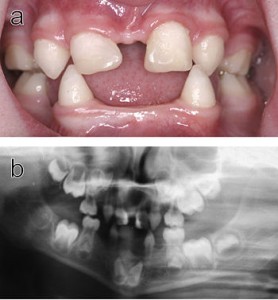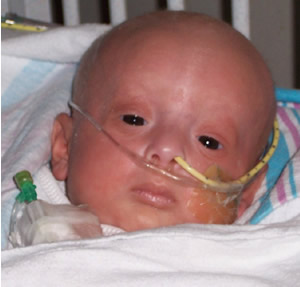Ectodermal dysplasia (ED) gives rise to abnormalities in various physical structures like nails, teeth, hair and sweat glands. Inform yourself completely about this condition, including its causes, symptoms, diagnosis and treatment.
What is Ectodermal Dysplasia?
Page Contents
It refers to a group of inherited disorders that is characterized by abnormalities in the tissues of ectodermal origin. This includes ears, nails, teeth, hair, lips and certain other parts. Ectoderm refers to the last layer of cells in the embryonic development. It is involved in the development and formation of body parts described above. In this disease, there is disrupted growth of ectoderm in certain regions of the body.
ED is also known by other names like HED, EDA and CST syndrome.
Types of Ectodermal Dysplasia
Since the disease itself involves a group of disorders, a proper classification is necessary. There are more than 150 types of disorders involved in the classification. The four major types of ED are as follows:
Picture 1 – Ectodermal dysplasia
- ED1: Trichodysplasia (Hair Dysplasia)
- ED2: Dental dysplasia
- ED3: Onychodysplasia (Nail Dysplasia)
- ED4: Dyshidrosis (Sweat Gland Dysplasia)
Based on these four primary types, ED has been classified into a number of subgroups. The hypohidrotic form (which belongs to the subgroup 1-2-3-4) and the hydrotic form (which falls under subgroup 1-2-3) are the most common of these subtypes.
Causes of Ectodermal Dysplasia
The major causes of this disorder are:
Genetic mutation
ED arises due to a mutation of genes located in specific chromosomes. The mutation varies depending on the type of the disease that one suffers from.
Heredity
Since ED is an inherited disorder, it tends to pass on from one generation to another.
De Novo Mutation
In rare cases, de novo mutation may occur, which results in occurrence of this disease even without a medical or family history. This means that a person can suffer from the disease even without anyone in his/her family (such as either of the parents) having it at any time.
Know about the genes involved in some important types of ED:
- Hay-Wells syndrome, Rapp-Hodgkin syndrome and EEC syndrome: TP63
- Ellis–van Creveld syndrome: EVC
- Hypohidrotic ectodermal dysplasia: EDA, EDAR, and EDARADD
- Naegeli syndrome: KRT14
- Margarita Island ectodermal dysplasia: PVRL1
- Focal dermal hypoplasia: PORCN
- Ectodermal dysplasia with skin fragility: PKP1
- Clouston’s hidrotic ectodermal dysplasia: GJB6
Symptoms of Ectodermal Dysplasia
Reduced sweating is one of the most common and unique symptoms of this disorder. As a patient with ED is unable to sweat properly, he/she suffers from an abrupt increase in body temperature, even in mild illness. A person suffering from this disease is also unable to tolerate very warm temperature.
Some of the other common symptoms of the disease include:
- Abnormality in nails, hair, teeth, lips, nose and mouth.
- Possible absence of teeth and sparseness of the hairs.
- More pointed appearance of teeth (that are present).
- Probable enamel complications in a few patients. In most cases, dental replacements are required.
- Affected vision and hearing capacity.
- Severely affected temperature regulation of the body.
- Broad nose and longer chins are also common.
- Possible respiratory infections, which occur in the nose due to absence of mucous glands that results in dryness.
- Affected taste sensations, which are another major characteristic of this disease. This is because of the fact that salivary gland functioning is impaired. In extreme cases, the salivary glands might be absent.
- Absence or underdevelopment of nipples or mammary glands in women. This makes it impossible for suffering women to breast feed.
- Vaginal dryness, as observed in some women.
- Lower body weight than normal, as observed in some suffering children. This is attributed to affected chewing ability in children, occurring due to missing teeth.
- Problems in swallowing, which results in frequent vomiting.
- Speaking difficulties, arising due to the presence of pointed teeth.
Ectodermal Dysplasia Diagnosis
The diagnosis of the disease involves an analysis of the ectodermal organs of the suspected individual. In this process, the ectodermal structures are carefully observed and then matched with those who have suffered from this disease in the past. If the structures have similar abnormalities, there are chances that the person is suffering from ED. The physical appearance of a child affected with this disorder also provides a lot of information. For instance, suffering children exhibit broad nose, wide chins, dense hair and abnormally dry skin. X-ray is also used to find out the exact number of tooth buds present in the jaw of a child suspected of having this condition.
In order to find out the specific type of ED, the technique of DNA screening is used. This test provides information about the gene where mutation has occurred. This process involves taking blood sample out of the vein from the arm of the patient, followed by an isolation of DNA from the blood cells. This technique of DNA screening is limited only to a few hospitals and research laboratories. The prenatal analysis of the disease is also possible although one should talk to doctors about the complications involved in the process. The study of family history can also provide vital clues, thus ensuring an early diagnosis of the disease.
Ectodermal Dysplasia Treatment
Unfortunately, no specific treatment has yet been developed for this condition. However, certain preventive measures can help you control the symptoms of ED.
Picture 2 – Ectodermal dysplasia Image
1) A person suffering from this disease should always be kept in a cool environment. A failure to do this can result in severe hyperthermia as the sweat glands do not function in ED sufferers. This is more important in case of summer season or warm environment.
2) In case a sufferer has to be administered with anesthesia, an anesthesiologist must be informed in advance. This is due to the fact that various preventive measures are required during administration of anesthesia in people having poor temperature regulation.
3) Use of artificial tears should be encouraged to prevent drying of the eye.
4) Dental replacements should be used in order to treat the dental abnormalities, which are quite common in this disease. The use of prostheses may be recommended by doctors. In children, removable prostheses are used which are replaced with fixed prostheses in adulthood.
5) Fluoride rinsing and fluoride tablets are used to combat the decreased secretion of saliva.
6) The nostrils should be cleaned manually in order to prevent the risks of infection.
7) People suffering from hypohidrotic ED should consult a dermatologist to get their skin treated.
8) In case constipation is noticed, the fluid intake of sufferers should be increased to treat the condition. In extreme cases, drugs may be prescribed to relieve constipation.
Although Ectodermal dysplasia does not reduce lifespan, its patients require constant care and monitoring to avoid serious health issues arising due to problems like poor temperature regulation. If you suspect a child in your family to be showing the symptoms of ED, get in touch with a health care professional at the earliest. Timely care and management would help you prevent all possible complications and ensure good health of sufferers.
References:
http://en.wikipedia.org/wiki/Ectodermal_dysplasia
http://www.geneskin.org/ectodermal-dysplasis.aspx
http://health.nytimes.com/health/guides/disease/ectodermal-dysplasia/overview.html
http://dermnetnz.org/hair-nails-sweat/ectodermal-dysplasia.html


